This post is Part 3 in a series of dispatches posted from a 130, 000 ton container ship. More here.
The bow of the ship is the only place on the Ever Cthulhu that affords a modicum of silence. To get there, you walk down the length of the narrow grey deck, flanked on one side by containers crowded into towering stacks that scrape and creak against each other as the ship cuts through the waves, and on the other by the powerful sweep of a wind so strong that you have to fight not to be blown backwards. At the foremost tip of the ship, you climb a few steps onto a large open deck painted grey and surrounded by giant chains and fat coils of synthetic rope, and suddenly, the mechanical roar of the ship falls away.
Having finally wended our way out of the US ports, the Ever Cthulhu has been traveling across the massive pacific ocean for more than a week now. Yesterday, we cleared the frigid Kamchatka Peninsula. The snow and ice beating against the ship for the past week has melted away, and the deck crew that has been trapped inside cleaning the walls and floors of the accommodations are now back to work on the endless task of the seaman: fighting against perpetual rust. “You know Sissyphus?”, The captain asks one day as we take a walk around the deck. “Working on a ship, it’s like that. You are fighting forever against the saltwater eating away at your vessel. The biggest enemy of the ship is not pirates, it’s corrosion.” Today, the ship has been awash in the sounds of grinding, scraping, hammering and drilling, scraping rust off and painting over it in an endless cycle that repeats itself every two months. All of this is set to the background soundtrack of an endlessly roaring engine that suffuses the air and shakes the accommodations with a throbbing, pulsating, machinic hum.
But on the bow, penned in from the wind and rage by the Ever Cthulhu’s bulwark, you can look outward onto an endless, unbroken horizon of ocean in near quiet, and almost think that the ship is barely moving. A quick step up onto a grilled ladder quickly dismisses this fantasy of a softly drifting ship: peering over the edge of the ship’s prow towards the churning waters below reveals the ship’s bulberous bow, a 1,000 ton snout-like protrusion of pure aerodynamic steel that cuts through the ocean, almost heaving the liquid blue upwards before pushing it back powerfully against the hull, where the waves churn themselves into a cerulean blue froth and then crest outwards in a diagonal wake. I can’t judge how far we are from the ocean’s surface, so I spit into the sea – crude, really – and count the seconds it takes to hit the waves. Seven. By the time it reaches the sea below, my ball of spit has already flown several meters behind me. We are forging ahead at a speed (18 knots per hour) beyond my bodily comprehension of motion. When you are surrounded by nothing but this limitless, shifting, liquid expanse, stretching in all directions for days before hitting land, all distance becomes incalculable.
In gazing at the uniformity of the open sea from the safety of this colossus, it has not ceased to amaze me how much this deep blue, whose liquid nature Carl Schmitt has suggested fundamentally confounds the very bases of political authority and law, constantly exceeds our firmly landed conceptions of territoriality and belonging. For centuries, humans have drawn rhumb lines, navigational routes, and territorial markers across the ocean’s surface, deigning to create roads and map sovereign claims onto inconstant, liquid matter. Yet, in swallowing whole planes such as the as-yet unrecovered Malaysian Airlines MH370, in evading the surveillance technologies we now expect to seamlessly take us to our landed destinations, and in absorbing and folding much of the Anthropocene’s heat into its warming depths, the shifting, turbulent, evasive ontology of the wet ocean contravenes the very idea of a stability-conferring foundation. On the open sea, Schmitt reminds us, there are “no limits, no boundaries, no consecrated sites, no sacred orientations, no law, and no property” – in short, none of the landlocked frameworks through which we might make sense of social and spatial terrain.
What then, to make of a mode of circulation suspended over this watery mass, a mode of circulation anchored in the mobility of these 130,000 ton vessels of solid steel, and relies precisely on the fluidity of the oceans to project extra-territorial power across vast distances? One way I have been approaching this question has been from perspective of quotidian life on the ship. As Cesare Casarino has suggested, after all, oceanic trade and navigation gave rise to a maritime working class that not only provided “the prototype of the associative and organised model of wage labour that was to become dominant under industrial capitalism”, but also anticipated the multinational, multilingual, and multiracial constitution of labour that so characterises the global political economy of our present.
Oceanic labour is globalised labour, though this may be banal point to make. More specifically, perhaps, oceanic labour is labour that experiences a sort of double alienation under circulatory capital: while in the classic Marxist formulation, alienation in the space of the factory dispossesses workers of the means of production, workers on container ships are differentiated from this labour pool in that the spaces they occupy are not spaces of production, but of circulation. If in the factory, machines removed the connection or satisfaction workers might have derived from the production of commodities, thus turning labour profoundly abstract, in the logistics circuit, workers are one more step removed. Containers, in their modular, block-like, homogeneous forms, wall off the goods being transported from those bodies transporting them. The container form, then, renders the containerized commodity utterly illegible to the workers charged with guarding and ensuring their movement.
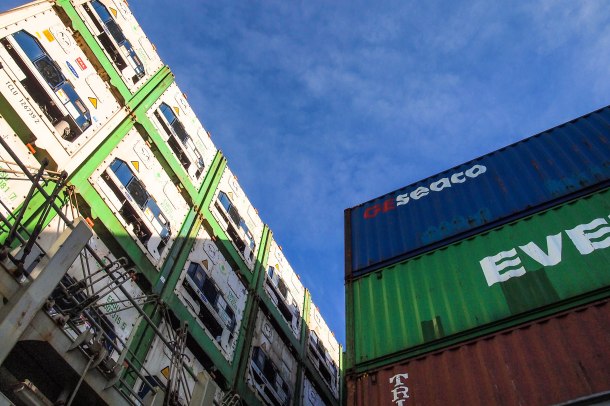
On the left, reefer (refrigerated) containers rise into the air and below deck, carrying fresh and frozen goods to China.
“Do you ever think about what’s in those containers?”, I ask Abled Bodied Seaman (AB) Montez. He shrugs. “No, almost never. Only when I have to check the reefer readings”. On one particularly freezing afternoon, I accompany him on one of these duties. With a clipboard and pen, we climb up and down of the container bays, and in and out of the cargo holds, laboriously looking for the bay, stack, and location of each listed reefer container, cross reference it with the container identification number imprinted on the container, and write down the temperature listed on the tiny monitor embedded in the door. Reefers are refrigerated containers, holding produce that needs to be either frozen or chilled. Except for the faint smell of apples, interlaced with the stench of heavy fuel oil, and a little notation on the clipboard that lists the type of food being carried, Montez knows nothing of the container’s contents – nor does he seem to care – as he weaves in and out of an endless parade of modular steel blocks. Recording all the reefer readings is a process that takes almost four hours, and has to be repeated every day, twice a day.
By the end, icicles have frozen on my eyelashes and our hands are numb. The only containers whose contents are made known to the ship’s crew are these reefers, and containers carrying dangerous cargo – a total of not more than fifteen containers listing ‘environmental pollutants’ or ‘marine pollutants’ – buried deep within the stacks. Other than that, ships no longer carry shipping manifests, so even the captain has no idea what the ship is moving. I learn from one pilot in Tacoma that the Ever Cthulhu is most likely carrying a surfeit of scrap steel and recycled plastic, which explains why the ship has been sitting so low in the water. While on the outbound journey from China to the US, ships are stuffed with manufactured goods being brought to American shelves, but in the other direction, most of what travels east is, the labour theorist Sergio Bologna has noted, “shit and air” – waste products and empty containers. In the end, Montez says of the contents of the containers, rubbing his hands together for warmth, “maybe it’s better not to know”. Untethered from the production process as a whole, further untethered from the content of the commodities they move across the ocean, the workers on the Ever Cthulhu crew neither identify with their jobs nor find connection or interest in the content of the work they perform. The labour of the seaman, subject to the blurred boundaries between production and circulation rendered by the logistics revolution, seems in this sense to be quite literally awash in a sea of flows.
I’ve started taking other jobs on the ship to get closer insight into the rhythms of the workday. The officers, for their part, have been exceedingly generous in giving me the smallest boiler suit in stock (four sizes too large) and steel-capped work shoes (two sizes too big), and jobs with “minimal danger” so that, in the event of an injury, I do not become an insurance nightmare. Once, walking into lunch in my work wear, the entire table of officers bursts into laughter. “What?” I ask, smiling. The Chief mate responds: “Let’s just say that if I was a passenger, even if I was doing research on the ship, I would not bore myself with daily jobs like this. In that suit.”
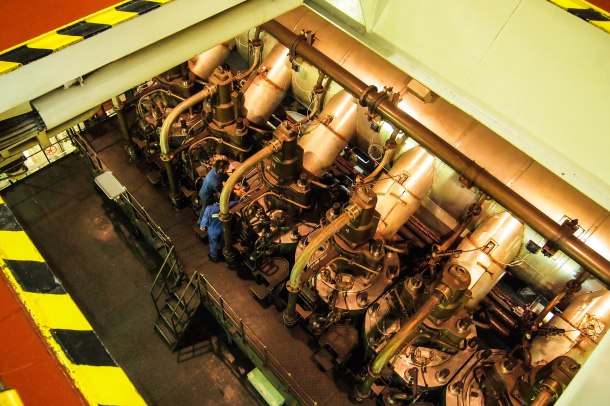
Below deck, two of the engine crew work at cleaning and closing the valves of the main engine’s pumps.
Escaping from the boredom of daily work life is, however, not a luxury the crew can afford. A container ship’s crew is split into two departments: the deck department works all the jobs above the hull in often debilitating weather conditions, scrubbing, cleaning, wiping, painting, de-rusting, and mooring the ship in the fore and aft when it is coming into harbour. Underneath, in the cavernous engine room that reaches eight stories below deck, the engine department toils – like the subterranean industrial society of H.G. Wells’ Morlocks – in stultifying heat and to the overwhelming roar of the ship’s engine.
One of the jobs I’ve worked (more a burden than a help, I’m sure,) has been to clean the engine room’s cooler – a contraption of hundreds of 8 by 4″ aluminium plates pressed tightly together by two thick steel covers – which pumps cold seawater into a tank that then cools by convection the freshwater circulating around the ship’s gargantuan engine. In four-hour shifts, for twelve hours a day, for four days straight, two workers worked at a time. First, the cooler’s walls are pried apart with a hydraulic pump. Each plate is slid down a rail, separating one from the other. While one worker used a brush to scrape the muck of the ocean caught between the plate walls, the other blasts it off with a high pressure water gun. There are four hundred double-sided plates to clean. Spray, scrape, brush, spray. On and on, hour after hour, the repetitive work starts to become mind numbing, but you cannot afford to wander because the water blaster, at 180 bars, is so powerful that a misdirected spray could cut a finger off. By the end of my four hour shift, I am covered in bits of the sea: little crustaceans, general brown clomps of dirt, and even a tiny silver fish, which the oiler Jonathan grabs and pretends to throw into his mouth.
On one of the days, halfway through the cooler cleaning project, the electrician Yunus alerts the engine department to the fact that there is a giant oil leak in the fuel duct. I wait for the crew to go in and examine the problem, and then crawl into the duct after them. Three ladders below even the lowest level of the engine room, the fuel duct is a tight passageway at the absolute bottom of the ship in the part of the hull submerged underwater, extending across the entire length of the vessel, though not more than four feet high. I step-crawl my way almost 250 meters to the front, where five engine crew are working.
We are in a tight, dimly light part of the duct from which water is dripping. Below me, separated by six-foot long sections of the ship’s steel skeleton, are pools upon pools of heavy fuel oil, jet-black and swirling with water. All this has leaked from a pipe that hasn’t been able to withstand the torsion caused by the past few stormy days on the ocean. The engine crew, rather despondently, is scooping the oil into plastic buckets with the help of a few dustpans and white rags. We crouch on hands and knees, ducking under the leaking fuel pipe that the fitter is desperately trying to repair, and work at clearing the oil in silence.
Heavy fuel oil (or HFO) is the crudest industrial fuel there is, made of a composite of hydrocarbons, the remaining dregs of the oil refinery process. Road tar is made from the same material, but here, over the ocean, the ship guzzles 118 tons of it a day. “Our main engine is a big waste dump”, the chief engineer once told me. Above deck, I have seen the HFO exhaust wafting into the horizon, staining the endless blue with a dirty, darkened smoke. Below deck, the oil is so acrid that it fills the back of my throat with a metallic, biting odour. Three hulking bags of blackened rags and six full buckets of HFO later, we are done with the job, but by then, my eyes and skin are stinging, my fingers stained orange through my gloves. It took four rounds of heavy industrial soap to get the poisonous HFO off my skin, and after three washes, the smell of the oil on my boiler suit still fills my room. I get to step off the ship in two weeks, but this is the sort of work that the engine department performs everyday: the tedious, banal, poisonous work of cleaning and maintenance.
Adem, the oldest wiper on the ship and a man with a philosophical disposition, encapsulates it this way: “dangerous, but boring. One hundred percent boring”. In cycles, each time a ship leaves port, engine and deck crews both rush around the ship to restore and maintain the ship, prolonging its life for as long as possible. Even the idea of ‘caring for the ship’, however, seldom guides the working mentalities of Ever Cthulhu‘s crew. Instead, “just follow orders” is the oft-repeated mantra. “Follow orders, finish the contract, go home to your family”, the fitter says. The captain has told me of parties and receptions held by chartering companies for the shareholders who hold stakes in the spanking new ships churned out of shipyards in eastern Europe and South Korea every few months, champagne and appetisers poured out for laughing guests. After the glamor of shipbuilding, after the enthralling rush of invention and innovation, maintenance is the leftover, dirty, dangerous but dull work left to the maritime working class. As if caught between immense parentheses, the seaman cannot claim to have built this world, only to help move it back and forth, and back again. Teddy bears and computer parts, shit and air, revolve around the earth because of the toil of sailors who care not why they are there – only that they will be home soon.
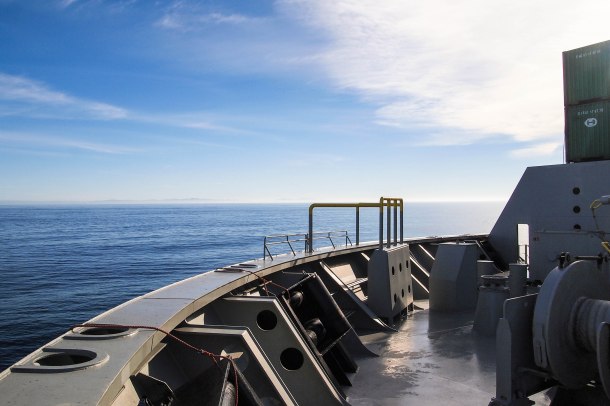
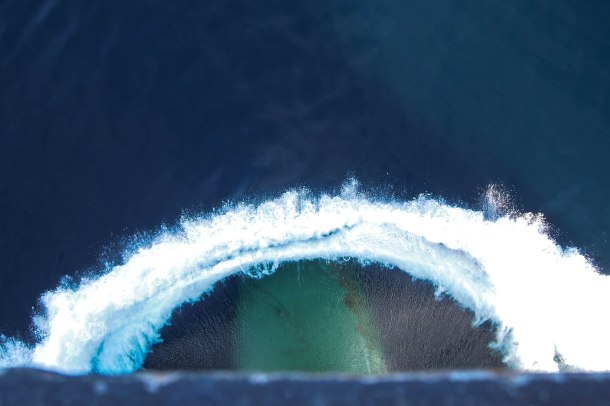
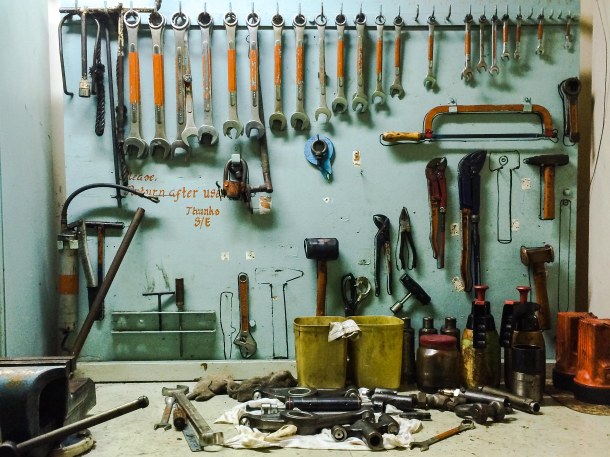
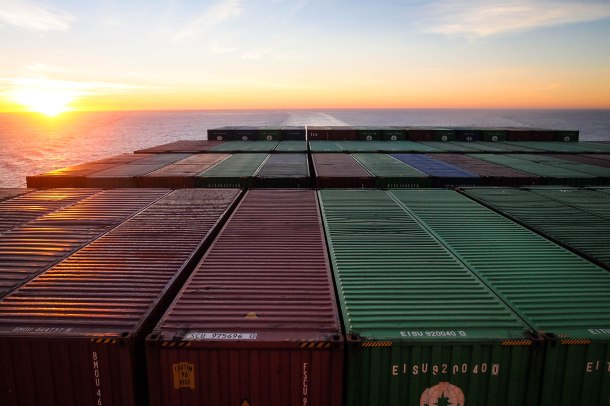
Thank you so very much for sharing. To be transported from a cold home in a snowy valley to the bowels of a container ship, well, it is quite a journey. I loved the picture of the tool board. Such basic tools! Take care.
LikeLike
This is tremendous. Beautifully composed images and sobering, insightful content. Thank you.
LikeLike
Pingback: Still Quiet | Randal Putnam Loves to Pedal
Can’t wait for your next dispatch….its engrossing stuff!
LikeLike
Pingback: Along the Liquid Path - &&& Journal&&& Journal